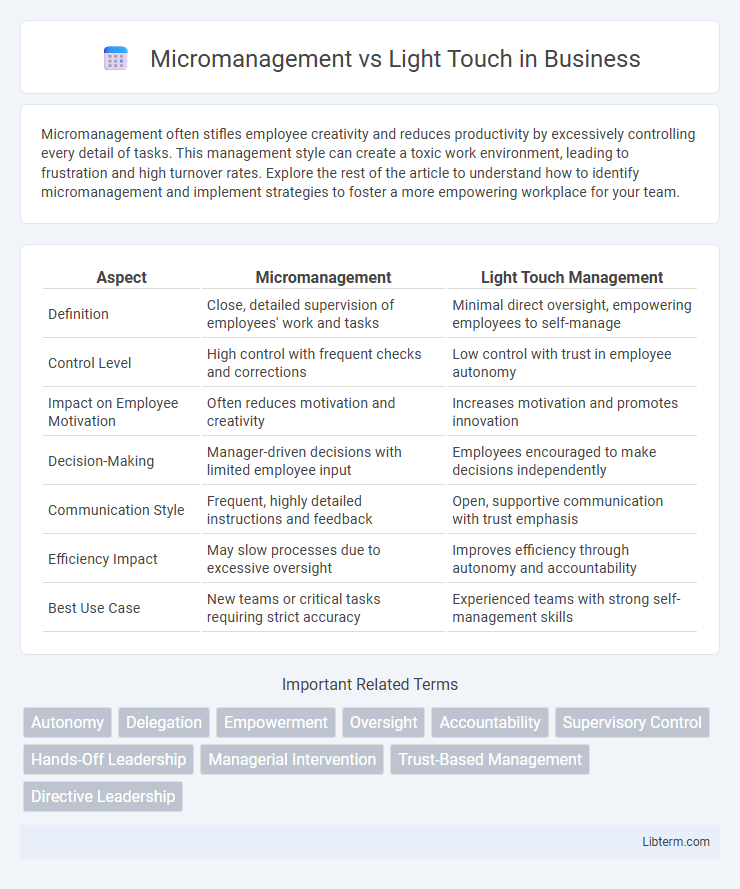Micromanagement often stifles employee creativity and reduces productivity by excessively controlling every detail of tasks. This management style can create a toxic work environment, leading to frustration and high turnover rates. Explore the rest of the article to understand how to identify micromanagement and implement strategies to foster a more empowering workplace for your team.
Table of Comparison
| Aspect | Micromanagement | Light Touch Management |
|---|---|---|
| Definition | Close, detailed supervision of employees' work and tasks | Minimal direct oversight, empowering employees to self-manage |
| Control Level | High control with frequent checks and corrections | Low control with trust in employee autonomy |
| Impact on Employee Motivation | Often reduces motivation and creativity | Increases motivation and promotes innovation |
| Decision-Making | Manager-driven decisions with limited employee input | Employees encouraged to make decisions independently |
| Communication Style | Frequent, highly detailed instructions and feedback | Open, supportive communication with trust emphasis |
| Efficiency Impact | May slow processes due to excessive oversight | Improves efficiency through autonomy and accountability |
| Best Use Case | New teams or critical tasks requiring strict accuracy | Experienced teams with strong self-management skills |
Understanding Micromanagement: Definition and Key Traits
Micromanagement involves excessive control and close monitoring of employees' work, often undermining autonomy and creativity. Key traits include frequent checking, detailed scrutiny, and reluctance to delegate tasks, leading to reduced employee motivation and productivity. Understanding these behaviors helps organizations identify and address micromanagement to foster a healthier work environment.
The Light Touch Approach: Principles and Benefits
The Light Touch approach emphasizes empowering employees through trust, autonomy, and minimal supervision, fostering innovation and higher job satisfaction. Core principles include clear goal-setting, open communication, and regular but non-intrusive check-ins to support accountability without micromanaging. This method boosts productivity by encouraging self-motivation and reduces stress, leading to improved team morale and long-term organizational success.
Impact on Team Morale and Productivity
Micromanagement often leads to decreased team morale as employees feel undervalued and overly controlled, resulting in reduced motivation and creativity. In contrast, a light touch approach fosters trust and autonomy, empowering team members to take initiative and enhancing overall productivity. Studies show that teams with supportive, non-intrusive leadership report higher job satisfaction and better performance outcomes.
Control vs. Trust: Striking the Right Balance
Effective leadership requires striking the right balance between control and trust, as micromanagement involves excessive oversight that stifles employee autonomy, while a light touch approach promotes empowerment and innovation through trust. Research shows that excessive control reduces job satisfaction and productivity, whereas trust-based management enhances engagement and organizational performance. Leaders who calibrate their involvement based on team capabilities foster a culture of accountability and creativity.
Early Signs of Micromanagement in the Workplace
Early signs of micromanagement in the workplace include excessive oversight of employees' daily tasks, frequent check-ins that disrupt workflow, and reluctance to delegate responsibilities. Constant monitoring undermines employee autonomy and stifles creativity, leading to decreased morale and productivity. Recognizing these behaviors early allows leaders to shift towards a light touch management style that fosters trust and empowerment.
Empowerment through Delegation: Light Touch Tactics
Light Touch management emphasizes empowerment through delegation by entrusting employees with autonomy to make decisions and solve problems independently, enhancing motivation and innovation. This approach reduces micromanagement tendencies by focusing on clear goal-setting, providing necessary resources, and offering support without constant oversight. Empowered teams under Light Touch tactics demonstrate increased accountability and higher performance levels due to the trust placed in their capabilities.
Case Studies: Micromanagement vs Light Touch in Action
Case studies reveal that micromanagement often leads to decreased employee morale and reduced productivity, as seen in corporations like Wells Fargo where excessive oversight stifled innovation. Conversely, companies like Google demonstrate that a light touch management style fosters creativity and autonomy, resulting in higher employee engagement and successful project outcomes. Data from these case studies emphasize the impact of leadership style on organizational effectiveness and employee satisfaction.
Leadership Styles and Company Culture
Micromanagement leadership style involves close supervision and control over employees' tasks, often leading to reduced autonomy and stifled creativity within company culture. Light touch leadership emphasizes trust and empowerment, fostering a collaborative environment that encourages innovation and employee engagement. Organizations adopting light touch approaches typically experience higher morale and adaptability, which positively impacts overall performance and retention.
Transitioning from Micromanagement to Light Touch
Transitioning from micromanagement to a light touch approach involves shifting focus from controlling every detail to empowering employees with autonomy and trust. This change enhances team productivity, fosters innovation, and improves job satisfaction by encouraging self-direction and accountability. Leaders who adopt a light touch emphasize clear communication, set expectations, and provide support only when necessary, driving sustainable performance.
Best Practices for Sustainable Leadership
Effective sustainable leadership balances micromanagement with a light touch by empowering teams through clear goal-setting and consistent feedback while avoiding excessive control that stifles autonomy. Best practices include fostering transparent communication, delegating responsibilities thoughtfully, and promoting accountability to build trust and resilience within the organization. Emphasizing employee development and adaptability ensures long-term growth and innovation without burnout or disengagement.
Micromanagement Infographic

 libterm.com
libterm.com